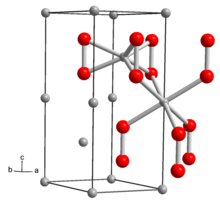
| |
 | |
| Names | |
|---|---|
| IUPAC name
Lithium peroxide
| |
| Other names
Dilithium peroxide
Lithium(I) peroxide | |
| Identifiers | |
3D model (JSmol)
|
|
| ChemSpider | |
| ECHA InfoCard | 100.031.585 |
PubChem CID
|
|
| UNII | |
CompTox Dashboard (EPA)
|
|
| |
| |
| Properties | |
| Li2O2 | |
| Molar mass | 45.885 g/mol |
| Appearance | fine, white powder |
| Odor | odorless |
| Density | 2.32 g/cm3[1][2] |
| Melting point | Decomposes to Li2O at ~450°C but melts at 197°C[3] |
| Boiling point | NA |
| soluble[vague] | |
| Structure | |
| hexagonal | |
| Thermochemistry | |
Std enthalpy of
formation (ΔfH⦵298) |
-13.83 kJ/g |
| Hazards | |
| GHS labelling: | |
 
| |
| Danger | |
| H271, H272, H314 | |
| P210, P220, P221, P260, P264, P280, P283, P301+P330+P331, P303+P361+P353, P304+P340, P305+P351+P338, P306+P360, P310, P321, P363, P370+P378, P371+P380+P375, P405, P501 | |
| NFPA 704 (fire diamond) | |
| Related compounds | |
Other cations
|
Sodium peroxide Potassium peroxide Rubidium peroxide Caesium peroxide |
Except where otherwise noted, data are given for materials in their standard state (at 25 °C [77 °F], 100 kPa).
| |
Lithium peroxide is the inorganic compound with the formula Li2O2. Lithium peroxide is a white solid, and unlike most other alkali metal peroxides, it is nonhygroscopic. Because of its high oxygen:mass and oxygen:volume ratios, the solid has been used to remove CO2 from and release O2 to the atmosphere in spacecraft.[4]
- ^ "Physical Constants of Inorganic Compounds," in CRC Handbook of Chemistry and Physics, 91st Edition (Internet Version 2011), W. M. Haynes, ed., CRC Press/Taylor and Francis, Boca Raton, Florida. (pp: 4-72).
- ^ Speight, James G. (2005). Lange's Handbook of Chemistry (16th Edition). (pp: 1.40). McGraw-Hill. Online version available at: http://www.knovel.com/web/portal/browse/display?_EXT_KNOVEL_DISPLAY_bookid=1347&VerticalID=0
- ^ Phys.Chem.Chem.Phys.,2013,15, 11025. doi:10.1039/c3cp51056e
- ^ Cite error: The named reference
Greenwoodwas invoked but never defined (see the help page).
